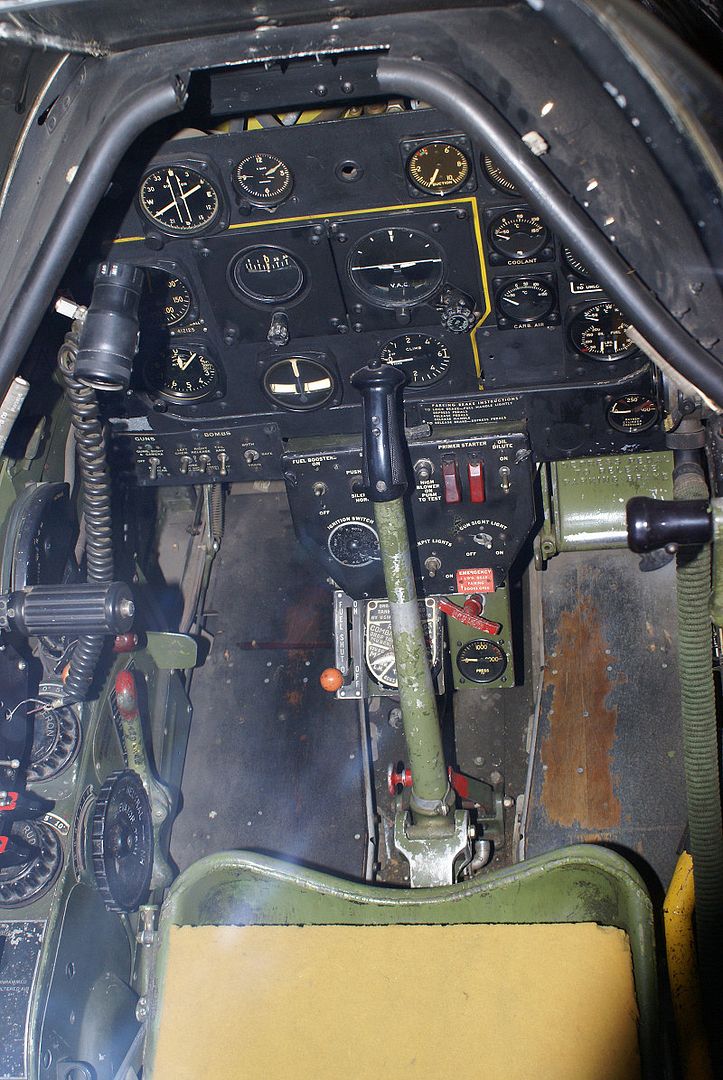The Crawford Museum's P-51K-10-NT 44-12116, and the Netherlands AF Museum P-51K-10-NT 44-12125, are, quite literally, separated "twins" (essentially sister ships), and both having never been completely restored, and remaining untouched (though missing items) since original manufacture.
Here's a photo from my collection, taken by one of my Dutch friends, of the cockpit of the Netherlands AF example. Note, that being a P-51K-10-NT, the aircraft are near identical to the P-51D-15-NA, of around September/October 1944 production-status, and thus quite early, especially considering the many other, much later production models that survive today. What's also great about 44-12125, at the the Netherlands AF Museum, is that it is a 78th FG (Duxford-based) combat vet. The aircraft retains the early features such as the single carb control lever (for ram and unrammed air - before the fitting of a carb heat control lever), and the early, pre-rocket controls switch panels. The aircraft is also one of those within the era of production, that had the electrical primer switch introduced, and the manual Parker primer removed. Despite this change, the instrument panel surrounds continued to be manufactured just the same, with the mounting holes still present for the manual primer lever (as fitted on the lower right-hand side of the instrument panel, next to the oxygen pressure gauge). As a result, a cover plate was simply screwed into place covering these holes, as clearly can be seen in this photo (the same also went for all P-51D-15-NA and NT's, as well as early model P-51D-20-NA's). During mid P-51D-20-NA production, the instrument panel surround was finally changed, and the oxygen flow gauge, that was mounted previously on the instrument panel surround above the right longeron, was now repositioned next to the oxygen pressure gauge, near to where the original manual primer pump was once located (on the restored "Twilight Tear", the presence of this cover plate is correctly copied, per an authentic to early model P-51D-20-NA detail - on the "Upupa Epops", a late model P-51D-20-NA, it has, correctly, the later redesigned instrument panel surround).
Also note, that P-51K-10-NT's (as well as P-51D-15-NA's, early model P-51D-20-NA's, and all earlier or otherwise equivalent models) came from the factory with N-9 reflector gun sights installed. As shown in the photo below, there is ample evidence that the aircraft was field modified with the installation of the K-14 gun sight (or perhaps a British equivalent). The rough notch/cut-out in the instrument panel shroud, was a common in-field modification, done in order to move the K-14 gun sight forward more from the factory installed location, so that it wasn't so much right in the pilot's face. The throttle is also of an early style 'twist-grip' type, used with the computing gun sights like the K-14.
My favorite details lie in the preserved/original paint and primer finishes. This photo, when in its full resolution form, provides an excellent look at the original font/letter face types used for the stencils. A very rare stencil, that is also present on the Crawford Museum's example, reading "LAND GEAR DOWN" with a downward facing arrow, applied to the side of the trim console just above the gear lever, I have never seen in any other period photos, and the only restoration I believe I have seen it recreated on, is in John Session's P-51B "Impatient Virgin". The floor boards are also wonderful, showing the original non-slide black paint finish, as well as the wear patterns from the pilot's feat, exposing the original wood below. (A note to the modelers: The rivets that you can see on the floor boards were originally painted over at the factory, with the non-slide black paint, and thus would not have shown when new. With wear, the rivets are exposed. Although some are symmetrical, seen the same on either floorboard, several are not.) Also note the interior green painted gear lever with the red painted tip. This seems common to early/mid production models, where as P-51D-20's and later models seem to have most often had all-black painted gear levers.
Also, "if" the instruments present have remained installed as they are since original manufacture, as I suspect they could be, it's interesting in that the clock and the VSI are mounted recessed, rather than the usual and called-for forward mounting (for this instrument panel type).
As seen in Taigh Ramey's photos of the Crawford Museum example in the link in the previous post by Mike, it shares many of the same preserved details (though it still retains its original ball-grip throttle lever, illustrating that it likely never was upgraded from having the N-9 reflector sight installed at the factory (it being a state-side aircraft during the war)).






